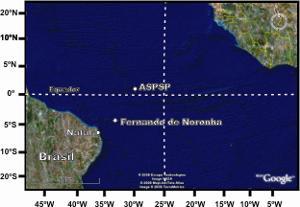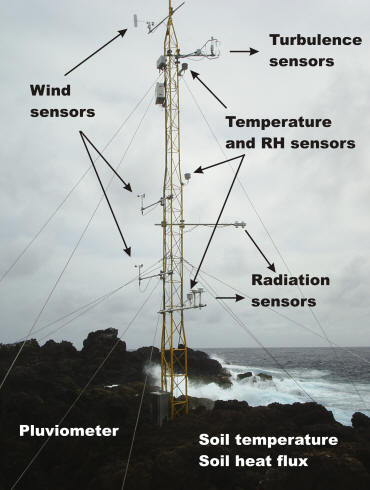Projects
Group of Micrometeorology - IAG/USP
FluTuA Project
Fluxos Turbulentos no Atlântico
Sponsored by Fapesp, CNPq and SECIRM.
The first objective of this project is to investigate the ocean-atmosphere interaction through direct observational determination of the vertical turbulent fluxes of sensible heat, latent heat and momentum, in the Archipelago of São Pedro e São Paulo (00° 56 'N and 29° 22' W) using fast response sensors installed on a micrometeorological tower of 10 meters. The use of a tower has several advantages over other methods of turbulent measurement because, being fixed, the tower has no interference due to the platform movements. It was also measured the meteorological variables in three levels of high enabling the validation and calibration of the parameterizations currently used in oceanic and atmospheric numerical models.

Measurements in the surface boundary layer (CLS) over the ocean provide information on vertical exchanges of sensible and latent heats, moisture and momentum between ocean and atmosphere. These measures, along with information of radiation and precipitation, allow a better understanding of climate processes and their interactions. They also allow the definition and validation of the coupling conditions for numerical models of oceanic and atmospheric micro, meso and large scales.
To measure turbulence, it was used a set of sensors of fast response - three-axis sonic anemometer and LIQUOR hygrometer - installed at 10 meters from surface, giving observations of fluctuations of the three components of wind, temperature and vapor density of air, with a frequency sampling between 1 and 30 Hz.

Simultaneously, slow response sensors provided measurements of air temperature, air relative humidity and wind speed at 3 levels of height, using the micrometeorological tower. These measures will allow, an alternative and indirect way, to estimate the air-sea interface flows by adjusting the average profiles of specific humidity, air temperature and horizontal wind speed to the vertical profiles provided by the Monin-Obukhov Similarity Theory (TSMO). This method, identified here as an indirect method requires variable observations in at least two vertical levels and average values of variables at time intervals of 5 minutes to 1 hour. The indirect method use is restricted to the TSMO validity conditions over the ocean.
Measurements of precipitation, components of radiation balance, atmospheric pressure, sea surface temperature, soil temperature and soil heat flux were also made during FluTuA. The atmospheric pressure sensor provided observations of the pressure temporal march needed to estimate the specific humidity from the air humidity.
The data obtained during the experiment will have several immediate applications:
Calculation of the radiation balance over the ocean;
Calculation of the energy balance over the ocean;
Calculation of CO2 flux;
An estimate of the momentum transfer of heat and humidity;
Estimation of wind stress on the region.
Researcher responsible: Jacyra Soares.